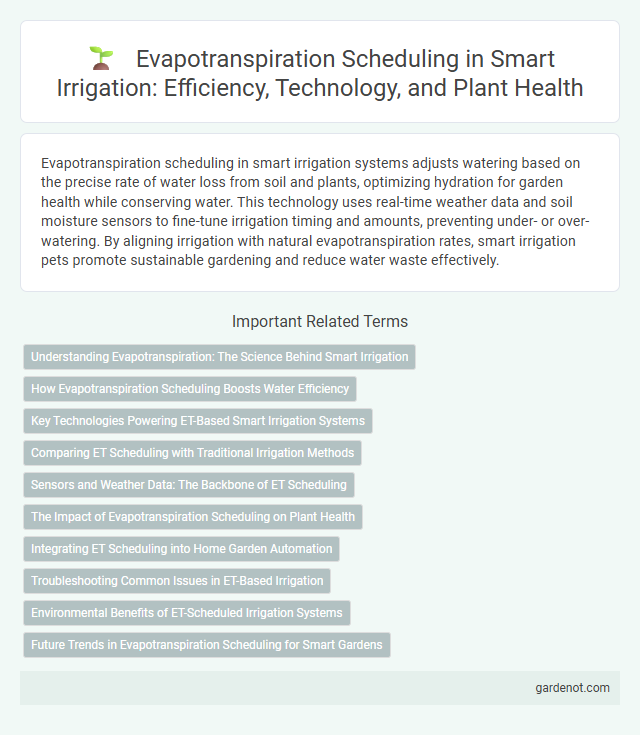Evapotranspiration scheduling in smart irrigation systems adjusts watering based on the precise rate of water loss from soil and plants, optimizing hydration for garden health while conserving water. This technology uses real-time weather data and soil moisture sensors to fine-tune irrigation timing and amounts, preventing under- or over-watering. By aligning irrigation with natural evapotranspiration rates, smart irrigation pets promote sustainable gardening and reduce water waste effectively.
Understanding Evapotranspiration: The Science Behind Smart Irrigation
Evapotranspiration (ET) is the combined process of water evaporation from soil and transpiration from plants, serving as a critical indicator for smart irrigation systems to optimize water use based on real-time plant water needs. Accurate ET measurement incorporates climatic data such as temperature, humidity, solar radiation, and wind speed, enabling precise scheduling that prevents overwatering and conserves resources. Advanced ET-based smart irrigation deployments enhance crop health and yield by dynamically adjusting irrigation timing and volume, aligning water application with natural water loss rates.
How Evapotranspiration Scheduling Boosts Water Efficiency
Evapotranspiration scheduling enhances water efficiency by aligning irrigation timing and volume with the actual water loss through evaporation and plant transpiration. This precise approach reduces water waste and supports optimal crop growth by supplying plants with the exact moisture they need. Implementing evapotranspiration-based irrigation systems contributes to sustainable water management and lowers overall water consumption in agricultural practices.
Key Technologies Powering ET-Based Smart Irrigation Systems
Evapotranspiration (ET) scheduling relies on real-time data from climate sensors, soil moisture probes, and weather stations to optimize water application tailored to crop needs. Advanced algorithms integrate satellite imagery and IoT connectivity to predict ET rates, enabling precise irrigation timing and volume adjustments. Machine learning models further enhance system efficiency by analyzing historical ET patterns, reducing water waste and improving crop yield sustainability.
Comparing ET Scheduling with Traditional Irrigation Methods
Evapotranspiration (ET) scheduling optimizes water usage by aligning irrigation with actual crop water needs, reducing waste compared to traditional fixed-timing irrigation methods. Traditional irrigation often relies on preset schedules without considering real-time climatic variables, leading to overwatering or underwatering. ET scheduling integrates climate data, soil moisture, and crop specifics, enhancing water efficiency and promoting sustainable agricultural practices.
Sensors and Weather Data: The Backbone of ET Scheduling
Sensors measuring soil moisture, temperature, and humidity combined with real-time weather data enable precise evapotranspiration scheduling for smart irrigation systems. This integration optimizes water use efficiency by adjusting irrigation based on actual plant water needs and environmental conditions. Advanced ET scheduling reduces water waste, promotes crop health, and supports sustainable agricultural practices.
The Impact of Evapotranspiration Scheduling on Plant Health
Evapotranspiration scheduling enhances plant health by precisely matching water application to the actual moisture loss through evaporation and transpiration, reducing water stress and promoting optimal growth. This method minimizes overwatering and underwatering, which are primary causes of root diseases and nutrient deficiencies. By maintaining balanced soil moisture, evapotranspiration scheduling supports robust photosynthesis and improves plant resilience against environmental stresses.
Integrating ET Scheduling into Home Garden Automation
Integrating evapotranspiration (ET) scheduling into home garden automation optimizes water usage by tailoring irrigation to real-time plant water needs based on weather data and soil conditions. Smart sensors and IoT devices monitor temperature, humidity, solar radiation, and soil moisture to calculate accurate ET rates, reducing water waste and enhancing plant health. This technology enables precise, automated irrigation cycles that adapt dynamically, ensuring efficient water management and promoting sustainable gardening practices.
Troubleshooting Common Issues in ET-Based Irrigation
Evapotranspiration (ET) scheduling in smart irrigation systems often encounters issues such as inaccurate weather data, sensor malfunctions, and improper calibration, leading to inefficient water use. Ensuring real-time integration of localized meteorological data and routine sensor validation improves ET estimation accuracy and irrigation timing. Addressing these challenges enhances water conservation and promotes optimal crop health.
Environmental Benefits of ET-Scheduled Irrigation Systems
Evapotranspiration-scheduled irrigation systems optimize water use by applying only the amount necessary to meet crop demands, reducing water wastage and conserving freshwater resources. These systems lower runoff and leaching, minimizing nutrient loss and protecting soil quality, which contributes to healthier ecosystems. Integrating ET scheduling promotes energy savings by decreasing pump usage and supports sustainable agriculture through enhanced water use efficiency.
Future Trends in Evapotranspiration Scheduling for Smart Gardens
Future trends in evapotranspiration scheduling for smart gardens revolve around integrating AI-driven predictive analytics with real-time sensor data to optimize water usage. Advanced IoT devices will enable precise monitoring of soil moisture, weather patterns, and plant water needs, significantly reducing water waste. These innovations aim to enhance sustainable irrigation practices by dynamically adjusting watering schedules based on environmental changes and plant growth stages.
Evapotranspiration scheduling Infographic

 gardenot.com
gardenot.com